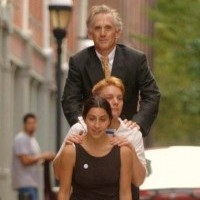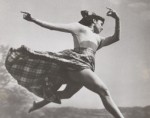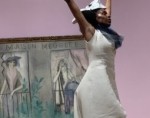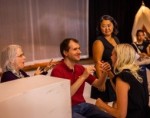
Photo: Anja Hitzenberger
The Spirits in David Zambrano’s Soul Project
by Jonathan Stein
Ringmaster David Zambrano, dressed to the nines in candy cane-striped tails and sporting a full white beard, stepped barefoot onto the cobblestone street adjoining Christ Church Neighborhood House to mingle among his waiting audience. In Venezuelan-inflected English, he called them to attention to introduce a work that has become a legendary performance celebration since its 2006 debut in Amsterdam.
“We’ll all be on stage together,” he said as he prepared his audience for standing and for frequent shifts in their location, positions that would be in very close proximity to his dancers, who would present “solo after solo after solo after solo. . . .” Suddenly, a shouted “be careful,” erupted from the crowd, as the Mozambique dancer Edivaldo Ernesto thrust his tall, lithe body among us, and with twisted, torquing torso, lunges and jabbing motions that sometimes ended inches in front of someone’s face, he coughed out the words to Cuban songwriter Bola de Nieve’s Be Careful, it’s My Heart, in staccato bursts of agony.
We were warned, we were warmed, we were ready for Soul Project to begin.
The work is organized around over a dozen largely soul and R&B songs played at random via an iPod shuffle with a curiously expectant audience awaiting the sudden commencement of an improvised solo from one of the seven dancers (including Zambrano) who circulate among us amidst moving spotlit epicenters. Zambrano has
described this as an “ego-centric” structure representative of capitalist countries, although it is the artist here with the power, however fleeting its duration.
And although the dancers do not follow the lyrics, they do channel and re-create the emotional intensity of the songs with an almost shattering impact on us that can only come from viewing those possessed by a spirit.
Horacio Macuacua’s every muscle and nerve shook, shuddered, and shivered to the words of the Civil Rights era anthem by Baby Huey, A Change is Gonna Come, which the Mozambique dancer also punctuated with screams and guttural shouts, and an occasional triumphant laugh. You felt that he was not only fully embodying the song but a politics that he insisted with every cell of his body needed to be present today. Macuacua later brought his ferocious intensity to Gloria Gaynor’s disco anthem, I Will Survive, shedding mid-song his shirt festooned with old bottle caps and medals (that gave him the appearance of a contemporary African sculpture) for a woman’s shirt with a leopard pattern that he plucked from a willing audience member.
Ernesto, this time with a shaggy, blond wig that obscured his face and white lace arm-length gloves, danced an anguished solo to Bettye Lavette’s You’ll Never Change, keeping both feet planted into the floor, rooting his sorrow into the earth. In one solo without music, Slovakian Peter Jasko, wearing a deep blue body suit with gold sequined diamond trim up the sides (and sequined eyelashes to match), kept the side and top of one foot also fixed to the ground as he attempted energetic movement with every other part of his body. Slovakian Milan Herich, bare-chested with green-checkered pantaloons, brought his muscular jumps and circling squatted runs to At Last, sung by Stevie Nicks, and the searing rendition of La llorona, (The Weeper) by the late Coast Rican-Mexican singer, Chavela Vargas, giving equal intensity to love won and lost. Memorable solos were also provided by Nina Fajdiga of Slovenia, Young Cool Park of South Korea, and Zambrano himself, whose concentration, gaze and muscle control plunged Living Without You into darker despair.
When Aretha Franklin’s Spirit in the Dark began all the dancers engaged the whole space in what was clearly their (and our) anthem for the evening. Yet despite Aretha’s urging of “let’s start dancing,” very few in an audience of many dancers did dance, highlighting a conundrum of the form, which offered in its club-like setting the allure and illusion of a participatory dance exchange. Zambrano’s aim rather was to present the dancer as “being continuously alive” or as he also has said, “You have to be fire,” which he equates with the soul. Although mostly passively standing or sitting around the spotlit circles, this audience nevertheless joined Zambrano in celebrating the soul as we shared his and his dancers’ joy of moving.
David Zambrano,
Soul Project, venue, September 18-19. And
September 25 & 26, 8 pm (free) Lang Performing Arts Center at Swarthmore College, and with Informance 9/27 at 1 pm, www.jumatatu.org/center-gravity-rhythm/.
By Jonathan Stein
September 19, 2015







.png)


